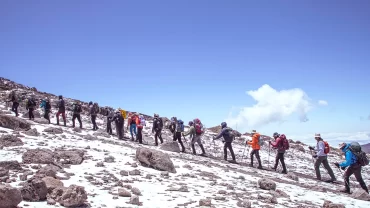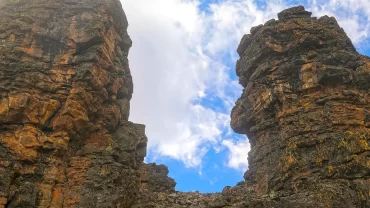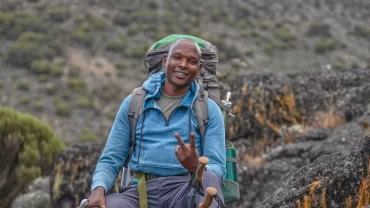There’s something magical about waking up to the distant roar of a lion, the soft rustling of acacia leaves, and the golden hues of an African sunrise stretching across the Serengeti. But for anyone planning a safari, one question lingers—when is the best time for safari in Tanzania?
The answer isn’t simple. The beauty of Tanzania is that every month offers something unique. Whether it’s the drama of a Mara River crossing, the joy of witnessing newborn wildebeests taking their first steps, or the serenity of a rain-kissed savanna, every season has its wonders. Let’s take a journey through the months and discover what makes each one special for an unforgettable safari experience.
January – February: Calving Season & Predator Drama
The air is thick with anticipation. In the southern plains of the Serengeti, nearly 500,000 wildebeests are born in a span of a few weeks. Tiny calves wobble on unsteady legs, their mothers nuzzling them gently. But danger lurks in the tall grasses. Lions, cheetahs, and hyenas wait in the shadows, ready to strike.
This is one of the most action-packed times for safari-goers. The predator-prey interaction is intense, and photographers can capture raw moments of survival. The skies are clear, the temperatures warm, and the landscapes lush, making it an ideal time for game viewing.
- Best safari parks: Southern Serengeti, Ndutu Plains, Ngorongoro Crater
- Best for: Predator action, wildebeest calving, dramatic photography
March – May: The Green Season & Tanzania’s Best-Kept Secret
Heavy rains arrive, painting the land in emerald green. The dry, dusty plains transform into a paradise of wildflowers and glistening waterholes. Many tourists shy away from safaris during this season, but those who venture here are rewarded with solitude, incredible birdwatching, and discounted safari prices.
Picture yourself in Tarangire National Park, watching an elephant herd playfully splashing in the mud, or cruising along the Rufiji River in Selous, with nothing but the calls of African fish eagles breaking the silence. The wildlife is still abundant, and the storms often arrive in short, spectacular bursts, leaving behind vibrant sunsets.
- Best safari parks: Selous Game Reserve, Tarangire, Lake Manyara
- Best for: Lush landscapes, fewer tourists, birdwatching
June – July: The Great Migration Begins
The Serengeti awakens as the Great Migration moves north, with millions of wildebeests, zebras, and gazelles making their way toward the Grumeti and Mara Rivers. The dry season is setting in, and water sources are becoming scarce, concentrating wildlife around permanent rivers and watering holes.
Imagine standing in an open safari vehicle at dawn, the air crisp and fresh, watching a pride of lions strategizing their next hunt. Elephants march across the plains, their tusks gleaming in the morning light. The cool temperatures and minimal rain make game drives comfortable and rewarding.
- Best safari parks: Central & Western Serengeti, Ruaha, Ngorongoro Crater
- Best for: The beginning of the Great Migration, excellent predator sightings
August – September: The Drama of the Mara River Crossings
This is safari season at its peak. The Great Migration reaches the Mara River, where thousands of wildebeests take their chances against powerful currents and lurking crocodiles. The tension is palpable. Some hesitate at the river’s edge, while others leap fearlessly into the water, battling for survival.
Meanwhile, Tarangire National Park comes alive with massive elephant herds, and Ngorongoro Crater offers some of the best chances to spot rhinos. The weather is perfect, the skies are clear, and Tanzania’s landscapes offer postcard-worthy views at every turn.
- Best safari parks: Northern Serengeti, Ngorongoro, Tarangire
- Best for: The Mara River crossings, elephant herds, peak wildlife activity
October – Early November: The Last Days of the Dry Season
As October arrives, the land is parched, and animals gather in tight clusters around the last remaining water sources. Game viewing is still spectacular, with heightened predator activity. The dry grasses make spotting wildlife easier, and the tourist crowds begin to thin out, offering a more intimate safari experience.
Then, in early November, the short rains return, breaking the heat and refreshing the landscapes in a matter of days. Elephants rejoice, rolling in the mud, and the scent of fresh earth fills the air. It’s a transitional period, offering the best of both the dry and green seasons.
- Best safari parks: Serengeti, Tarangire, Ruaha
- Best for: Big game sightings, fewer tourists, beautiful landscapes
Late November – December: The Cycle Begins Again
With the return of the rains, the Great Migration makes its way back south to the lush Ndutu plains, completing the cycle once again. This is a fantastic time for baby animals, migratory birds, and dramatic cloud-filled skies. The golden light after an afternoon rain shower makes for breathtaking photography.
For those looking for a quieter safari away from peak season crowds, December is an excellent choice. The festive season adds a special charm, with many lodges offering Christmas and New Year’s safari packages, blending wildlife adventures with warm hospitality.
- Best safari parks: Southern Serengeti, Lake Manyara, Selous
- Best for: Newborn wildlife, lush scenery, festive safari experiences
Choosing the Best Time for Safari in Tanzania
Ultimately, the best time for safari in Tanzania depends on what you want to experience:
- For the Great Migration: June to September (river crossings) or January to February (calving season).
- For Predator Sightings: January to March (hunting during calving season) or June to October (when water scarcity leads to intense predator-prey interactions).
- For Lush Landscapes & Fewer Crowds: March to May (green season) or November to December (short rainy season).
- For Birdwatching & Baby Animals: November to May, when migratory birds and newborns fill the parks.
Conclusion
There’s no wrong time to visit Tanzania—only different kinds of magic waiting to be discovered. Whether you crave the heart-pounding action of a river crossing, the peace of a secluded green-season safari, or the thrill of tracking a lion through golden grass, every month offers its own unforgettable moments.
So, when is the best time for safari in Tanzania? That depends on what calls to you. Are you ready to answer the wild’s invitation?





Comment (0)